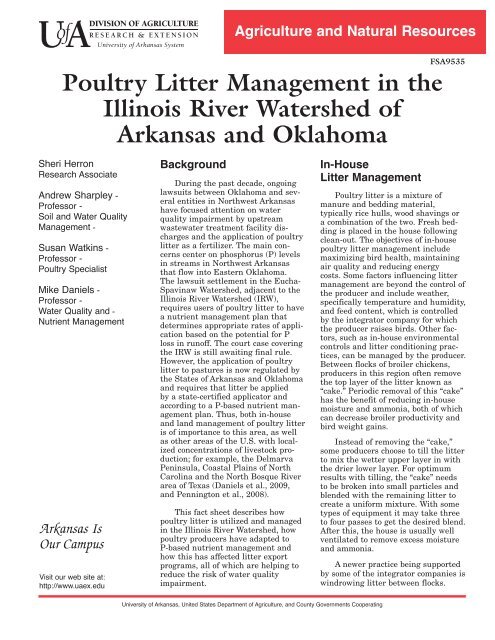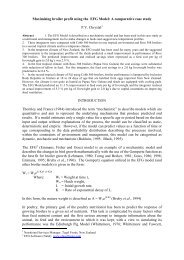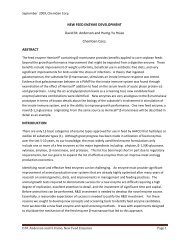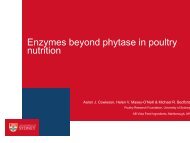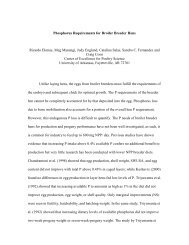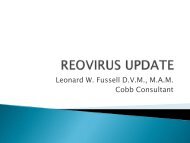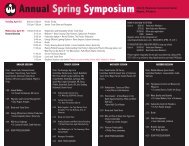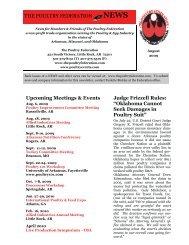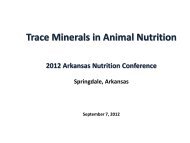Poultry Litter Management in the Illinois River Watershed of ...
Poultry Litter Management in the Illinois River Watershed of ...
Poultry Litter Management in the Illinois River Watershed of ...
Create successful ePaper yourself
Turn your PDF publications into a flip-book with our unique Google optimized e-Paper software.
<strong>Litter</strong> is formed <strong>in</strong>to two rows <strong>the</strong> length <strong>of</strong> <strong>the</strong>poultry house, with each row be<strong>in</strong>g at least 3 to 4 feethigh for best results. With proper conditions, w<strong>in</strong>d row<strong>in</strong>g litter can result <strong>in</strong> biological activity and heatproduction that partially composts <strong>the</strong> litter. If <strong>the</strong>heat production reaches 130ºF <strong>in</strong> <strong>the</strong> piles, it canreduce pathogen populations that are a threat to birdhealth. For optimum effectiveness, <strong>the</strong> rows areturned after 72 hours and allowed to heat a secondtime. Follow<strong>in</strong>g <strong>the</strong> second cycle, w<strong>in</strong>drowed litter isredistributed <strong>in</strong> <strong>the</strong> house for <strong>the</strong> next flock <strong>of</strong> birds.Ideally, temperatures should reach 130ºF both times.Aga<strong>in</strong>, it is important to ventilate <strong>the</strong> house wellafter w<strong>in</strong>drow<strong>in</strong>g to avoid ammonia<strong>in</strong>duced healthproblems for <strong>the</strong> next flock <strong>of</strong> birds. W<strong>in</strong>d row<strong>in</strong>gnecessitates a downtime between flocks <strong>of</strong> at least10 days, with additional days needed to prepare <strong>the</strong>house for <strong>the</strong> next flock.from <strong>the</strong> house. Thus, determ<strong>in</strong><strong>in</strong>g <strong>the</strong> nutrientcontent <strong>of</strong> litter is an important consideration whenus<strong>in</strong>g litter as a fertilizer. Determ<strong>in</strong><strong>in</strong>g nutrient contentrequires collect<strong>in</strong>g a litter sample ei<strong>the</strong>r <strong>in</strong>housebefore cleanout or from stacked litter after cleanout(Wilson et al., 2006, and Zhang et al., 2011) andsubmitt<strong>in</strong>g <strong>the</strong> sample to <strong>the</strong> University <strong>of</strong> ArkansasDiagnostic Test<strong>in</strong>g Laboratory or <strong>the</strong> OklahomaState University Soil, Water and Forage AnalyticalLaboratory <strong>in</strong> Oklahoma through your local countyExtension <strong>of</strong>fice.<strong>Poultry</strong> litter that is used <strong>in</strong> <strong>the</strong> Arkansas IRW asa fertilizer for pastures, haylands and crop fieldsmust be analyzed for nutrient content every 5 years,as required by state law. In Oklahoma, state lawrequires that litter be analyzed annually. <strong>Litter</strong> thatis exported <strong>of</strong>f <strong>the</strong> farm is analyzed each time it ishauled. The nutrient content <strong>of</strong> litter varies with feedmanagement, which is controlled by <strong>the</strong> <strong>in</strong>tegratorsalong with <strong>in</strong>house feeder pan, brood feed<strong>in</strong>g andlitter management, as mentioned above and bySharpley et al. (2009) and Zhang et al. (2011). As feedand litter management can vary from year to year,values used to estimate total nutrient production,current fertilizer value and pric<strong>in</strong>g for markets arebased on <strong>the</strong> previous year’s litter analyses averagesby bird type. Table 1 lists <strong>the</strong> averages for 2011 basedon litter analyzed by <strong>the</strong> University <strong>of</strong> Arkansas SoilTest<strong>in</strong>g Laboratory and provided by Nathan Slaton,director <strong>of</strong> <strong>the</strong> University <strong>of</strong> Arkansas Division <strong>of</strong>Agriculture’s Soil Test<strong>in</strong>g Program.TABLE 1. Mean nutrient content <strong>of</strong> poultry litter analyzedby <strong>the</strong> University <strong>of</strong> Arkansas Diagnostic Test<strong>in</strong>g Laboratory<strong>in</strong> 2011 (Slaton, personal communication 2012).Example <strong>of</strong> w<strong>in</strong>drowed poultry litterBroiler producers utilize one or a comb<strong>in</strong>ation <strong>of</strong><strong>the</strong> practices above for <strong>in</strong>house litter managementbetween flocks and typically remove all <strong>of</strong> <strong>the</strong> litterfrom <strong>the</strong> house once per year. Turkey producerstypically remove <strong>the</strong> cake or remove all <strong>of</strong> <strong>the</strong> litterbetween flocks, as <strong>the</strong>ir growout periods are muchlonger than for broiler chickens. Chicken hen andpullet producers generally remove all <strong>of</strong> <strong>the</strong> litterbetween flocks.When birds are present, litter moisture andammonia are managed us<strong>in</strong>g heaters and ventilationfans to ma<strong>in</strong>ta<strong>in</strong> ideal <strong>in</strong>house conditions for birdhealth. Outdoor wea<strong>the</strong>r conditions <strong>in</strong>fluence <strong>the</strong>moisture and temperature <strong>of</strong> <strong>the</strong> <strong>in</strong>com<strong>in</strong>g ventilationair and greatly impact <strong>the</strong> <strong>in</strong>tensity <strong>of</strong> this management,determ<strong>in</strong><strong>in</strong>g <strong>the</strong> need for ei<strong>the</strong>r heat<strong>in</strong>g orcool<strong>in</strong>g.Nutrient Content and Fertilizer Value<strong>Poultry</strong> litter is not typically managed to <strong>in</strong>creaseits fertilizer value; however, <strong>in</strong>house managementdoes affect <strong>the</strong> nutrient content <strong>of</strong> litter and its valueas a fertilizer for pastures and crops, when removedBird Type N P 2 O 5 K 2 O%Moisturelb/ton on an as is basisBroiler 64 55 58 25.8Hen 47 60 43 27.0Pullet 49 66 42 26.1Turkey 65 63 49 26.4Similar trends and nutrient contents <strong>of</strong> poultrylitter were obta<strong>in</strong>ed for prior years (Sharpley et al.,2009, and Zhang et al., 2011). Based on averagenutrient content, <strong>the</strong> value <strong>of</strong> poultry litter, ascompared to commercial fertilizer prices, can beestimated. Table 2 lists <strong>the</strong> values as <strong>of</strong> January 15,2012.TABLE 2. Average value <strong>of</strong> poultry litter based on itsnutrient content and commercial fertilizer prices from fourfertilizer dealers <strong>in</strong> Eastern Oklahoma as <strong>of</strong> January 15,2012.<strong>Litter</strong> Type N 1 P 2 O 5 K 2 O Total$/ton on an as is basisBroiler $25 $26 $31 $82Hen $19 $29 $23 $71Pullet $19 $32 $22 $73Turkey $26 $30 $26 $821 N value is based on 70% availability.
<strong>Management</strong> <strong>of</strong> <strong>Poultry</strong> <strong>Litter</strong>Removed From HousesAverage litter production by bird type is<strong>in</strong>fluenced by many factors and is most accuratelydocumented based on <strong>the</strong> quantity removed annuallyas cake and cleanout. Table 3 lists watershedbasedestimates <strong>of</strong> <strong>the</strong> annual quantity <strong>of</strong> litter generatedby bird type and removed from <strong>the</strong> house. These estimateswere based on <strong>the</strong> current number <strong>of</strong> housesprovided by <strong>the</strong> poultry <strong>in</strong>dustry. Average tons <strong>of</strong>litter removed per house annually were estimatedfrom data based on <strong>in</strong>dividual load weights providedfrom poultry litter truck<strong>in</strong>g companies ga<strong>the</strong>red dur<strong>in</strong>g2006 through 2011 and compiled by BMPs Inc.TABLE 3. Estimated annual litter production <strong>in</strong> <strong>the</strong> IRW(Data compiled by BMPs Inc. from data provided bypoultry litter truck<strong>in</strong>g companies).Avg. TonsRemovedPer HouseAnnuallyTotal TonsRemovedAnnually# HousesBird Type <strong>in</strong> IRWBroiler 1,133 195 1 220,935Hen 211 120 25,320Pullet 195 100 19,500Turkey breeder 27 75 2,025Turkey growout 53 132 7,000TOTAL 1,606 274,7801 Average tons removed per broiler house annually is <strong>the</strong> sum <strong>of</strong>140 tons <strong>of</strong> clean-out and 55 tons <strong>of</strong> cake litter.Removed litter that cannot be immediately landapplied or exported from <strong>the</strong> watershed is stored temporarilyonsite beneath litter stack<strong>in</strong>g sheds, whichkeep litter stored on top <strong>of</strong> concrete and under coveras a means <strong>of</strong> conta<strong>in</strong>ment and keep<strong>in</strong>g <strong>the</strong> litter dry.<strong>Poultry</strong> litter stack<strong>in</strong>g sheds provide safe, temporaryon-site storage <strong>of</strong> litter by keep<strong>in</strong>g <strong>the</strong> litter dry andconta<strong>in</strong>ed. (Nhoto Qourtesy <strong>of</strong> OiQh MountP<strong>in</strong>ConservPtion DistriQt)<strong>Poultry</strong> litter is ultimately land applied asfertilizer or exported via truck<strong>in</strong>g out <strong>of</strong> <strong>the</strong> watershed.Land application <strong>of</strong> poultry litter <strong>in</strong> <strong>the</strong> IRW<strong>in</strong> Arkansas and Oklahoma is regulated by statelaws, both requir<strong>in</strong>g analyses <strong>of</strong> soil and litter todeterm<strong>in</strong>e application rates, which m<strong>in</strong>imize <strong>the</strong> risk<strong>of</strong> P loss <strong>in</strong> run<strong>of</strong>f. Arkansas tracks litter application<strong>in</strong> <strong>the</strong> IRW through <strong>the</strong> nutrient managementplann<strong>in</strong>g process, which is supervised by Wash<strong>in</strong>gtonand Benton County Conservation Districts. Nutrientmanagement data has been compiled by <strong>the</strong> ArkansasNatural Resources Commission (ANRC), dat<strong>in</strong>g backto 2007, to evaluate <strong>the</strong> impact <strong>of</strong> us<strong>in</strong>g <strong>the</strong> ArkansasPhosphorus Index (ARPI) on litter application rates<strong>in</strong> <strong>the</strong> IRW. The <strong>in</strong>dex was recently updated and plannersbegan us<strong>in</strong>g <strong>the</strong> newly revised version <strong>in</strong> 2010.S<strong>in</strong>ce 2007, almost 740 nutrient managementplans have been developed, cover<strong>in</strong>g 46,920 acres.The average litter application rate prior to <strong>the</strong> implementation<strong>of</strong> <strong>the</strong> revised ARPI was 2.3 tons/acre. Ifall <strong>the</strong> planned acres received litter at <strong>the</strong> averagerate, it would amount to 107,920 tons utilized annually<strong>in</strong> <strong>the</strong> Arkansas portion <strong>of</strong> <strong>the</strong> IRW. Start<strong>in</strong>g <strong>in</strong>2010, <strong>the</strong> average litter application is 1.6 tons/acreus<strong>in</strong>g <strong>the</strong> revised ARPI, result<strong>in</strong>g <strong>in</strong> 75,080 tonsplanned for application annually <strong>in</strong> <strong>the</strong> Arkansasportion <strong>of</strong> <strong>the</strong> IRW.Oklahoma tracks litter application <strong>in</strong> <strong>the</strong> IRWthrough required records submitted by OklahomaRegistered <strong>Poultry</strong> Feed<strong>in</strong>g Operations and licensedwaste applicators. Current data is for 2009 and 2010,as compiled by <strong>the</strong> Oklahoma Department <strong>of</strong> Agriculture,Food and Forestry. Land application <strong>of</strong> litter <strong>in</strong><strong>the</strong> Oklahoma IRW dropped from 31,660 tons <strong>in</strong> 2009to 7,770 tons <strong>in</strong> 2010.While reductions <strong>in</strong> litter application rates haveoccurred, it is difficult to create an accurate massbalance due to <strong>the</strong> difference <strong>in</strong> <strong>the</strong> methods used byeach state to collect litter utilization data.<strong>Litter</strong> Export ProgramIn 2005, <strong>the</strong> five primary poultry <strong>in</strong>tegratorcompanies <strong>in</strong> Northwest Arkansas committed to <strong>the</strong>Oklahoma Scenic <strong>River</strong>s Commission (OSRC) toexport 202,500 tons out <strong>of</strong> <strong>the</strong> IRW over a 3yearperiod. Thiscommitment was<strong>the</strong> catalyst for<strong>the</strong> creation <strong>of</strong><strong>the</strong> coord<strong>in</strong>atedlitter export program,which nowtransports over100,000 tonsannually from<strong>the</strong> IRW. Thislitter is transportedto nonnutrient sensitive watersheds, ma<strong>in</strong>ly <strong>in</strong> Oklahomaand Kansas, for use primarily on cropped fields(Penn et al., 2011).To assist with meet<strong>in</strong>g <strong>the</strong> commitment to OSRC,both Oklahoma and Arkansas committed EPA 319hfunds to <strong>of</strong>fset a portion <strong>of</strong> <strong>the</strong> truck<strong>in</strong>g costs and paypoultry producers for <strong>the</strong>ir litter, <strong>in</strong> <strong>the</strong> amount <strong>of</strong>$1.3 million <strong>in</strong> grants and match<strong>in</strong>g funds. Thegrants were adm<strong>in</strong>istered by BMPs Inc, a nonpr<strong>of</strong>itcorporation established <strong>in</strong> 2004 for <strong>the</strong> purpose <strong>of</strong>
creat<strong>in</strong>g a poultry litter export <strong>in</strong>dustry. Follow<strong>in</strong>g<strong>the</strong> grant projects, ANRC adm<strong>in</strong>istered an additional$300,000 <strong>of</strong> federal, state and local fund<strong>in</strong>g for <strong>the</strong>export program <strong>in</strong> Arkansas (Fisk, 2009). Throughthis grant fund<strong>in</strong>g process, a coord<strong>in</strong>ated, largescalelitter haul<strong>in</strong>g system was created, <strong>in</strong>clud<strong>in</strong>g schedul<strong>in</strong>g,market<strong>in</strong>g and transportation. Although grantsubsidies are no longer available, local <strong>in</strong>dependenttruck<strong>in</strong>g companies cont<strong>in</strong>ue to operate today, transport<strong>in</strong>glitter <strong>in</strong> 23ton capacity semitrailers. <strong>Litter</strong>exports are tracked us<strong>in</strong>g certified scales to weigheach load.Table 4 summarizes <strong>the</strong> tonnage documented by<strong>in</strong>dependent haulers and poultry <strong>in</strong>tegrators asexported out <strong>of</strong> <strong>the</strong> watershed s<strong>in</strong>ce 2006 and may notbe a total account<strong>in</strong>g.SummaryTABLE 4. Tons <strong>of</strong> litter exported out<strong>of</strong> <strong>the</strong> IRW (from BMPs Inc.).Year Tons Exported2006 59,5202007 70,9702008 78,6802009 87,9902010 101,6002011 105,750Total 504,510Responses to environmental, legal and livestockproduction concerns, as well as <strong>in</strong>creas<strong>in</strong>g costs <strong>of</strong>bedd<strong>in</strong>g materials, have resulted <strong>in</strong> changes topoultry house and poultry litter management.Producers are implement<strong>in</strong>g litter managementpractices to improve <strong>the</strong> quality <strong>of</strong> <strong>the</strong>ir bedd<strong>in</strong>gmaterial. Nutrient management plans are reduc<strong>in</strong>g<strong>the</strong> maximum litter and <strong>the</strong>refore P application rates.This, com b<strong>in</strong>ed with a successful litter exportprogram, has resulted <strong>in</strong> a significant reduction <strong>in</strong><strong>the</strong> amount <strong>of</strong> litter applied <strong>in</strong> <strong>the</strong> watershed.Additional Read<strong>in</strong>gDaniels, M., B. Haggard and A. Sharpley. 2007. Arkansas watersheds.Cooperative Extension Service, Division <strong>of</strong> Agriculture,University <strong>of</strong> Arkansas. Fact Sheet FSA9521. 8 pages.Daniels, M., T. Scott, B. Haggard, A. Sharpley and T. Daniel. 2009.What is water quality? Cooperative Extension Service, Division<strong>of</strong> Agriculture, University <strong>of</strong> Arkansas. Fact SheetFSA9528. 5 pages.Fisk, P. 2009. <strong>Litter</strong> transport costshare program.http://www.arkansaswater.org/319/2009_Presentations/PDF/051600%20%20ANRC%20<strong>Litter</strong>%20Transport.pdf.Accessed May 4, 2012.Lavergne, T. K., M. Stephens, D. Schell<strong>in</strong>ger and W. Carney, Jr.2006. Inhouse pasteurization <strong>of</strong> broiler litter. Louisiana StateUniversity Agricultural Center Publication #2955.Mackl<strong>in</strong>, K., G. Simpson, J. Donald and J. Campbell. 2007.W<strong>in</strong>drow compost<strong>in</strong>g <strong>of</strong> litter to control diseasecaus<strong>in</strong>gpathogens. The <strong>Poultry</strong> Eng<strong>in</strong>eer<strong>in</strong>g, Economics and <strong>Management</strong>Newsletter. Issue 47. 4 pages. U.S. <strong>Poultry</strong> and Egg andAlabama <strong>Poultry</strong> and Egg Association.Malone, B. 2007. Inhouse compost<strong>in</strong>g <strong>of</strong> litter. Delmarva <strong>Poultry</strong>Industry, Timely Topics 24(4): 78.Payne, J., and H. Zhang. <strong>Poultry</strong> litter nutrient management:A guide for producers and applicators. Oklahoma CooperativeExtension Service, Division <strong>of</strong> Agricultural Sciences and NaturalResources, Oklahoma State University, Stillwater, OK.E1027. 15 pages. http://pods.dasnr.okstate.edu/docushare/dsweb/Get/Document7962/E1027.pdfPenn, C., J. Vitale, J. Payne, J. Warren and H. Zhang. 2011.An alternative poultry litter storage technique for improvedhandl<strong>in</strong>g, transport, and application: The “Mass ReductionSystems.” Oklahoma Cooperative Extension Serv. PSS2289.Oklahoma State University, Stillwater, OK. 4 pages.http://pods.dasnr.okstate.edu/docushare/dsweb/Get/Document8111/PSS2268%20web.pdfPenn<strong>in</strong>gton, J., M. Daniels and A. Sharpley. 2008. Us<strong>in</strong>g <strong>the</strong>watershed approach to ma<strong>in</strong>ta<strong>in</strong> and enhance water quality.Cooperative Extension Service, Division <strong>of</strong> Agriculture,University <strong>of</strong> Arkansas. Fact Sheet FSA9526. 8 pages.Sharpley, A., M. Daniels, K. VanDevender, B. Haggard, N. Slatonand C. West. 2010. Us<strong>in</strong>g <strong>the</strong> 2010 Arkansas phosphorus<strong>in</strong>dex. Cooperative Extension Service, Division <strong>of</strong> Agriculture,University <strong>of</strong> Arkansas. Miscellaneous Publication MP487.17 pages.Sharpley, A., M. Daniels, K. VanDevender and N. Slaton. 2010.Soil phosphorus: <strong>Management</strong> and recommendations.Cooperative Extension Service, Division <strong>of</strong> Agriculture,University <strong>of</strong> Arkansas. Fact Sheet FSA1029. 5 pages.Sharpley, A., N. Slaton, T. Tabler, K. VanDevender, M. Daniels,F. Jones and T. Daniel. 2009. Nutrient analysis <strong>of</strong> poultrylitter. Cooperative Extension Service, Division <strong>of</strong> Agriculture,University <strong>of</strong> Arkansas. Fact Sheet FSA9529. 6 pages.Sharpley, A., P. Moore, Jr., K. VanDevender, M. Daniels, W. Delp,B. Haggard, T. Daniel and A. Baber. 2010. Arkansas phosphorus<strong>in</strong>dex. Cooperative Extension Service, Division <strong>of</strong> Agriculture,University <strong>of</strong> Arkansas. Fact Sheet FSA9531. 8 pages.Wilson, M., M. Daniels, N. Slaton, T. Daniel and K. Van Devender.2006. Sampl<strong>in</strong>g poultry litter for nutrient content. CooperativeExtension Service, Division <strong>of</strong> Agriculture, University <strong>of</strong>Arkansas. Fact Sheet FSA9519. 4 pages.Zhang, H., D. W. Hamilton and J. Payne. 2011. Us<strong>in</strong>g poultry litteras fertilizer. Oklahoma Cooperative Extension Serv. PSS2246.Oklahoma State University, Stillwater, OK. 4 pages. http://www.poultrywaste.okstate.edu/files/pss2246web.pdfPr<strong>in</strong>ted by University <strong>of</strong> Arkansas Cooperative Extension Service Pr<strong>in</strong>t<strong>in</strong>g Services.SHERI HERRON is research associate and DR. ANDREWSHARPLEY is pr<strong>of</strong>essor soil and water quality management with<strong>the</strong> Crop, Soil and Environmental Sciences Department at <strong>the</strong>University <strong>of</strong> Arkansas, Fayetteville. DR. SUSAN WATKINS ispr<strong>of</strong>essor poultry specialist with <strong>the</strong> Center <strong>of</strong> Excellence for<strong>Poultry</strong> Science at <strong>the</strong> University <strong>of</strong> Arkansas, Fayetteville.DR. MIKE DANIELS is pr<strong>of</strong>essor water quality and nutrientmanagement with <strong>the</strong> Crop, Soil and Environmental SciencesDepartment, University <strong>of</strong> Arkansas Division <strong>of</strong> Agriculture, <strong>in</strong>Little Rock.FSA9535PD712NIssued <strong>in</strong> fur<strong>the</strong>rance <strong>of</strong> Cooperative Extension work, Acts <strong>of</strong> May 8and June 30, 1914, <strong>in</strong> cooperation with <strong>the</strong> U.S. Department <strong>of</strong>Agriculture, Director, Cooperative Extension Service, University <strong>of</strong>Arkansas. The Arkansas Cooperative Extension Service <strong>of</strong>fers itsprograms to all eligible persons regardless <strong>of</strong> race, color, nationalorig<strong>in</strong>, religion, gender, age, disability, marital or veteran status,or any o<strong>the</strong>r legally protected status, and is an AffirmativeAction/Equal Opportunity Employer.


